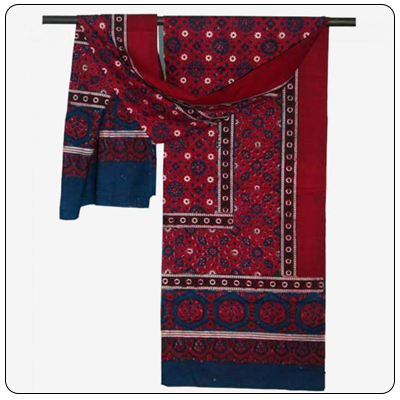In the world of South Asian textiles, few designs carry as much cultural depth and visual beauty as ajrak. This centuries-old craft from Sindh, Pakistan, has become an emblem of pride, identity, and artistry. The intricate patterns, deep natural dyes, and symbolic motifs tell stories of heritage, devotion, and craftsmanship that span generations.
At RS Bazaar, ajrak is more than fabric — it’s history woven by hand. Every pattern reflects a deep connection between artisans and the culture that inspires them.
The Origin and Cultural Importance of Ajrak
The word ajrak is derived from the Arabic term azrak, meaning “blue,” a reference to the indigo dye traditionally used in its creation. This textile art traces its roots to the ancient Indus Valley Civilization, making it one of the world’s oldest living craft traditions.
In Sindhi culture, ajrak symbolizes respect, hospitality, and pride. It is often presented as a token of honor to guests and worn during important cultural ceremonies. From festivals to weddings, the ajrak remains a powerful cultural identity — representing love for heritage and handmade art.
The Craftsmanship Behind Ajrak
The making of ajrak is a slow, deliberate process that can take weeks to complete. It combines centuries-old techniques of block printing, resist dyeing, and natural coloring.
Here’s a glimpse into the process:
- Preparation of the Cloth: The fabric is washed and treated with natural ingredients to make it dye-ready.
- Carved Wooden Blocks: Artisans hand-carve intricate geometric and floral designs on wooden blocks.
- Printing: The designs are printed layer by layer with natural dyes made from indigo, madder, turmeric, and clay.
- Washing and Sun-Drying: Between each dyeing stage, the fabric is carefully washed and sun-dried to bring out its deep, earthy tones.
The result is a visually striking textile where each piece of ajrak carries unique patterns and slight variations — proof that it was made by human hands, not machines.

Ajrak as a Symbol of Sindhi Identity
No cultural garment defines Sindh more vividly than ajrak. It is often draped over shoulders, used as a turban, or styled as a shawl during special occasions. For Sindhi people, ajrak is more than attire; it’s an expression of unity and pride.
Wearing ajrak connects individuals to their roots, reminding them of the rich history of craftsmanship that continues to thrive despite modernization. Whether in a rural village or a global fashion show, ajrak remains a proud emblem of Pakistani heritage.
Ajrak in Modern Fashion
While ajrak is deeply traditional, it has also evolved into a global fashion trend. Designers now reinterpret this classic textile in innovative ways, blending cultural patterns with contemporary silhouettes.
You’ll find ajrak in:
- Elegant scarves and shawls
- Kurtas and dresses
- Bags, shoes, and home décor
- Fusion outfits that combine traditional prints with modern cuts
The balance between old and new keeps ajrak relevant — appealing to people who value authenticity while embracing modern aesthetics.
Natural Dyes and Sustainable Practices
One of the most remarkable aspects of ajrak production is its eco-friendly nature. The dyes are made from natural sources like indigo plants, clay, tree bark, and flowers. Artisans use techniques that minimize waste and avoid chemicals, making ajrak a symbol of sustainable fashion.
Each ajrak piece represents responsible craftsmanship — proof that fashion can be ethical, beautiful, and meaningful. When you buy or wear ajrak, you support not only artisans but also environmentally conscious traditions.
Patterns and Symbolism in Ajrak
Every motif in ajrak carries cultural meaning. The geometric symmetry, floral borders, and intricate dots symbolize harmony, beauty, and the relationship between humanity and nature.
Common colors such as deep indigo, crimson red, and rich black are achieved through natural dyes, each with its own symbolism — blue for peace, red for vitality, and black for depth. Together, they create a masterpiece that embodies both strength and serenity.
Ajrak Beyond Borders
Though ajrak originated in Sindh, its appeal has crossed borders. From Pakistan to India, the Middle East, and beyond, it has been embraced by artists, designers, and historians for its cultural depth and aesthetic beauty.
Today, ajrak prints are showcased on global runways and in modern wardrobes. The combination of traditional craft and contemporary design makes it a timeless fabric that resonates universally.
Caring for Your Ajrak Fabric
Because ajrak is made using natural dyes and delicate processes, it deserves gentle care. To maintain its vibrance and texture:
- Hand wash in cold water with mild detergent.
- Avoid direct sunlight for drying.
- Do not bleach or machine wash.
By caring for it properly, you preserve not just a textile — but a tradition passed down through generations.
Why Ajrak Remains Timeless
The enduring charm of ajrak lies in its authenticity. In a world dominated by mass production, ajrak stands apart as a symbol of patience, artistry, and human touch.
Every pattern tells a story — of heritage, craftsmanship, and pride. It connects the past with the present, reminding us that true art never fades.
Whether worn on a festive day, gifted to a loved one, or displayed as home décor, ajrak continues to speak a universal language of elegance and identity.
Conclusion: Ajrak — A Living Tradition
The ajrak is more than just fabric; it’s a living piece of culture. It reflects centuries of creativity, respect, and heritage that continue to inspire new generations.
At RS Bazaar, ajrak is celebrated as a legacy — one that blends traditional artistry with modern expression. Owning an ajrak means carrying a story of the Sindhi soul, beautifully woven in every thread.


Leave a Reply